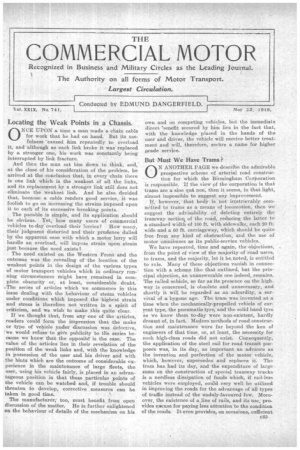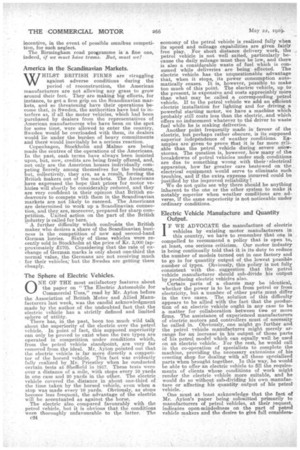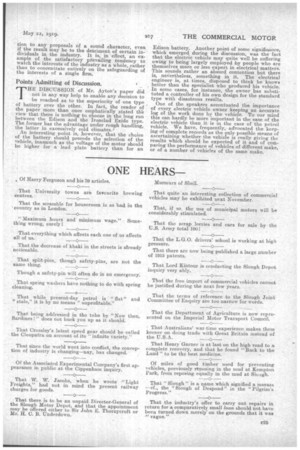Locating the Weak Points in a Chassis. ,
Page 1

Page 2

Page 3

If you've noticed an error in this article please click here to report it so we can fix it.
0 NCE UPON a time a man made a chain cable for work that he had on hand. But its usefulness 'caused him repeatedly to overload it, and although as each link broke it was replaced by a stronger one, his work was constantly being interrupted by link fracture.
And then the man sat him down to think, and,' at the close of his consideration of the problem, he arrived at the conclusion that, in every chain there is one link which is the .weakest of all the links, and its replacement by a stronger link still does noteliminate the weakest link. And he also decided that, because a cable renders good service, it was foolish to go on increasing the strains imposed upon it to each of its successive breaking points. The parable is simple, and its application should be obvious. Yet, how many users of commercial vehicles to-day overload their lorries? How many, their judgment distorted and their prudence dulled by the apparent ease with which a motor lorry will handle an overload, will impose strain upon strain just because the need exists? . The need existed on the Western Front and the outcome was the revealing of the location of the weakest points in the design of the various types of motor transport vehicles which in ordinary running circumstances Might have remained in corn-, plete obscurity or, at least, considerable doubt. ..The series of articles which we commence in this issue dealing with the behaviour of steam vehicles under conditions which imposed the highest strain and stress is therefore not written in a. spirit of criticism, and we wish to make this quite clear. If we thought that, from any one of the articles, readers could form the impression that the make or type of vehicle under discussion was defective, 'we would refuse to giite publicity to tlie series because we know that the opposite is the case. The value of the articles lies in their revelation of the position of the weak links and, with the knowledge in possession of the user and his driver and with the hints which are the outcome of considerable experience in the maintenance of large fleets, the user, using his vehicle fairly, is placed in an advantageous position in that these particular points of the vehicle can be watched and, if trouble should threaten to develop, corrective measures can be taken in good time. .
The manufacturer; too, must, benefit from open discussion of the matter. He is, further enlightenedon the behaviour of details of the mechanism on his own and on competing vehicles, but the immediate direct 'oenefit secured by him lies in the fact that, with the knowledge placed in the hands of the user and driver, the vehicle will receive better treatment and will, therefore, secure a name for higher wade service.
But Must We Have Trams ?
ON ANOTHER PAGE we describe the admirable prospective schrtne of arterial road construction for which the Birmingham Corporation is responsible. II the view of the corporation is that trams are a sine quA. non, then it seems, in that light, almost impossible to suggest any improvement. If, however, that bodyis not irretrievably committed to trams as a means of locomotion, then we suggest the advisability of deleting entirely the tramway sectior. of the road, reducing the latterto a standard width of 100 ft. with sidewalks, each 20 ft. wide and a 60 ft. carriageway, which should be quite free from any kind of obstruction, and the use of motor omnibuses as its public-service vehicles.. We have repeated, time and again, the Objections, from the point of view of the majority of road users, to trams, and the majority, let it be, noted, is entitled to rule. Many of these objections vanish in connect-ion with a scheme like that outlined, but the principal objection, an unanswerable one indeed, remains. he railed vehicle, so far as its presence on the high way is concerned, is obsolete and unnecessary, and Shortly it will be regarded as an adsurdity, a survival of a bygone age. The tram was invented at a time when the mechanically-propelled vehicle of current type, the pneumatic tyre, and the solid band tyre as we know them to-day were non-existent, hardly dreamt of, in fact. Modern methods of road construction and maintenance were far beyond the ken of engineers of that time, or, at least, the necessity for such high-class roads did not exist. Consequently, the application of the steel rail for road transit purposes was, in its day, as important an advance as the invention and perfection of the motor vehicle, which, however, supersedes and replaces it. The tram has had its day, and the expenditure of large sums on the construction of special tramway tracks is a needless dissipation of funds which, if rail-less vehicles were employed, could very well be utilized in improving the roads for the advantage of all types of traffic instead of the unduly-favoured few. Moreover, the existence of a.line of rails, and its use, pro vides eneuse for paying less attention to the condition of the roads. It even provides, on occasions, sufficient incentive, in the event of possible omnibus competition, for such neglect.
The Birmingham road programme is a fine one, indeed, if we must have trams. But, must we?
America in the Scandinavian Markets.
WHILST BRITISH FIRMS are struggling against adverse conditions during the period of reconstruction, the American manufacturers are not allowing any grass to grow around their feet. They are making big efforts, for instance, to get a firm grip on the Scandinavian markets, and so threatening have their operations become that, in Sweden, the authorities have had to interfere as, if all the motor vehicles, which had been purchased by dealers from the representatives of American manufaeturets who have been on the spot for some time, were allowed to enter the country, Sweden would be overloaded with them, its dealers would lie under the burden of heavy commitments and there would inevitably be a serious reaction.
Copenhagen, Stockholm and Malmo are being made the centres of the operations of the Americans. In the past, cash terms have always been insisted upon, but, now, credits are being freely offered, and, not only are the American houses individually competing fiercely among themselves for the business, but, collectively, they are, as a result, forcing the British inakers out of the markets. The Americans have expressed the hope that prices for motor vehicles will shortly be considerably reduced, and they are very confident in their opinion that British endeavours to compete with them in the Scandinavian markets are not likely to succeed. The Americans are determined to work up a Scandinavian connection, and they are, moreover, prepared for sharp competition. United action on the part of the British industry is called for here. . A further difficulty which confronts the British maker who desires a share of the Scandinavian business is the competition of new and second-hand German lorries. Sixty of these vehicles were recently sold in Stockholm at the, price of Kr. 3,000 (approximately 170). Considering that the rate of exchange of German marks is only about one-third the normal value, the Germans are not receiving much for their vehicles; but the Swedes are getting them cheaply.
The Sphere of Electric Vehicles.
ONE OF THE most satisfactory features about the paper on "The Electric Automobile for Commercial Uses," read by Mr. Ayton before the Association of British Motor and Allied Manufacturers last week, was the candid acknowledgment made by the author of the undoubted fact that the electric vehicle has a strictly defined and limited sphere of utility. There has, in the past, been too much wild talk about the superiority of the electric over the petrol vehicle. In point of fact, this supposed superiority can only be proved to exist when the two types are operated in competition under conditions which, from the petrol vehicle standpoint, are very far removed from the ideal. Mr. Ayton pointed out that the electric vehicle is far more directly a competitor of the horsed vehicle. This fact was evidently fully realized by Mr. Priestley when he conducted certain tests at Sheffield in 1917. These tests were over a distance of a mile, with stops every 10 yards in one case and 20 yards in the other. The electric vehicle covered the distance in about one-third of the time taken by the horsed vehicle, even when a stop was made every 10 yards. Obviously, as stops become less frequent, the advantage of the electric will be accentuated as against the horse.
The electric also compared favourably with the petrol vehicle, but it is obvious that the conditions were thoroughly unfavourable to the latter. The e2t1
economy of the petrol vehicle is realized fully when its speed and mileage capabilities are given fairly free play. For short distance delivery work, the petrol vehicle is not well suited, particularly because the daily mileage must then be lowt and there is also a considerable waste of fuel which is consumed while deliveries are being effected. The electric vehicle has the unquestionable advantage that, when it stops, its power consumption automatically ceases. It is, however, possible to make too much of this point. The electric vehicle, up to the present, is expensive and costs appreciably more than what may be called a corresponding petrol vehicle. If to the petrol vehicle we add an efficient electric installation for lighting and for driving. a powerful starting motor, we have a machine which probably still costs less than the electric, and which offers no inducement whatever to th6 driver to waste fuel while he is making deliveries. Another point frequently made in favour of the electric, but perhaps rather obscure, is its supposed superior independence of weather conditions. Examples are given .to prove that it is far more ieliable than the petrol vehicle during severe snowstorms. The question is, however, how many of the breakdowns of petrol vehicles under such conditions are due to something wrong with their ,electrical apparatus, how far greater care bestowed on the electrical equipment would serve to eliminate sueh troubles, and if the extra expense incurred could be justified by the improved reliability ?
We do not quite see why there should be anything inherent to the one or the other system to make it notably superior when weather conditions are adverse, if the same superiority is not noticeable under ordinary conditions.
Electric Vehicle Manufacture and Quantity Output.
IF WE ADVOCATE the manufacture of electric vehicles by existing motor manufacturers in this country, we have to remember that one is compelled to recommend a policy that is open to at least, one serious criticism. Our motor industry is being continually told -that it is its duty to reduce the number of models turned out in one factory and to go in for quantity output of the lowest possible number of types. Obviously, this policy is not fully consistent with the. suggestion that the petrol vehicle manufacturer should sub-divide his output by producing electric vehicles also.
Certain parts of a, chassis may be identical, whether the power is to be got from petrol or from electricity, but a number of other parts must differ in the two cases. The solution of this difficulty appears to be allied with the fact that the production of an electric vehicle ought in any case to be a, matter for collaboration between two or more firms. The assistance of experienced manufacturers of electric motors and controllers must of necessity be called in. Obviously, one might go further and the petrol vehicle manufactures might merely arrange for an increase in his output of those parts of his petrol model which can equally well be used on an electric vehicle. For the rest, he would call in the co-operation of specialists to complete the machine, providing the necessary extensions of his erecting shop for dealing with all those specialized parts when brought together. In this way, he would he able to offer an electric vehicle to fill the requirements of clients whose conditions of work might render the electric vehicle more suitable, and he would do so without sub-dividing his own manufacture or affecting his quantity output of his petrol vehicle.. One must at least acknowledge that the fact of Mr. Aytoia's paper being submitted primarily to manufacturers of petrol vehicles, at their request, indicates open-mindedness on the part of petrol vehicle makers and the desire to give full considerae tion to any proposals of a sound character, even if the result may be to the detriment of certain individuals in the industry. It is, in effect, an example of the satisfactory prevailing tendency to watch the interests of the industry as a whole,-rather than to concentrate entirely on the safeguarding of the interests of a single firm.
Points Admitting of Discussion. i
THE DISCUSSION of Mr. Ayton's paper did not in any way help to enable any decision to be reached as to the superiority of one type of battery over the other. In fact, the reader of the paper more than once emphatically stated the view that there is nothing to choose in the long run between the Edison and the Ironclad Exide type. The former has the advantage under rough handling, the latter in excessively cold climates./ An interesting point is, however, that the choice of the battery should precede the selection of the vehicle, inasmuch as the voltage of the motor should be higher for a lead plate battery than for an Edison battery. Another point of some significance, which emerged during the discussion, was the fact that the electric vehicle may quite well be suffering owing to being largely employed by people who are themselves more or less expert in electrical matters. This sounds rather an absurd contention but there is, nevertheless, something in it. The electrical engineer is, at times, disposed to think he knows better than the specialist who produced his vehicle. In some cases, for instance, the owner has substituted a controller of his own design for the standard . type with disastrous results.
, One of the speakers accentuated the importance of every electric vehicle • owner keeping an accurate log Of the work done by the vehicle. To our mind this can hardly be more important in the case of the electric vehicle than it is in the case of the petrol vehicle. We have, frequently, advocated the keeping of complete records as the only possible means of ascertaining whether the vehicle is really giving the results which should be expected of it and of coraparing the performance of vehicles of different make, or of a number of vehicles of the same make.






















